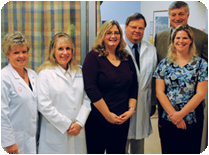Therapeutic Hypothermia After Cardiac Arrest

Virgina had no reason to suspect she would end up in RWJ Hamilton's emergency department (ED) when she left her house in Fort Monmouth early one morning. Virginia, a client service manager for a managed care company in Piscataway, was diving to an appointment when she went into cardiac arrest on Interstate 195.
|
"It was a typical early morning," says Virginia. "I was on the road before seven o'clock; headed to an appointment and the next thing I remember is waking up in the hospital a week later." |
As luck would have it, an emergency medical technician was just getting off work and was among the first responders to reach Virginia, who was now unresponsive. A state trooper soon arrived with an automatic external defibrillator (AED) and was able to shock Virginia's heart back to its normal rhythm.
Though her heart was restarted, Virginia was still unconscious and in critical condition when she arrived at the ED. RWJ Hamilton doctors and nurses provided immediate care.
"Her heart was restarted before arriving to our ED, but she remained minimally responsive," recalls emergency medicine physician Eileen Singer, DO. "We assessed her neurological condition and then immediately started therapeutic hypothermia."
RWJ Hamilton's emergency medical staff used cold intravenous saline and "cooling blankets" to chill Virginia's body to 91.4 degrees Fahrenheit before being transported to a teritary care hospital for further treatment. After about 24 hours, Virginia was re-warmed slowly.
Fast forward six months and Virginia only remembers waking up in the hospital room, but she is grateful to the staff at RWJ Hamilton for saving her life. Virginia's recovery is progressing well and she returned to work this past December.
As part of her recovery, she receives cognitive rehabilitation and is under the care of her cardiologist and neurologist.
"When something like this happens, the only thing you can do is trust the doctors and nurses taking care of you. I never heard of hypothermia treatment before that day, but it saved my life. Robert Wood Johnson Hamilton did everything they needed to do to make sure I was going to be okay."
|
How Therapeutic Hypothermia Works
RWJ Hamilton is one of only a few hospitals in the region actively treating post-cardiac arrest patients with a promising new cooling procedure called therapeutic hypothermia. Therapeutic hypothermia protects the brain and other vital organs by lowering oxygen requirements, deceasing cell swelling, and limiting the release of toxins, which can cause cells to die. It has been shown to improve neurological outcomes and increase survival in patients, like Virginia, who remain in a coma after being resuscitated. Experience with the treatment is injecting optimism in a field long plagued by frustration. Despite faster emergency squads, deployment of automated defribilators in public places, and improvements in cardiopulmonary resuscitation techniques, fewer than 10 percent of the 300,000 Americans who suffer cardiac arrest each year survive long enough to leave the hospital -- a rate that hasn't budged much over the years. "It's the only treatment shown to protect the brain after cardiac arrest," says Elizabeth Whetzel, a nurse educator who together with Dr. Singer and Cynthia Bascara, a critical care clinical nurse specialist, spearheaded bringing the procedure to RWJ Hamilton. All received certification in the administration and use of therapeutic hypothermia at the Hypothermia Training Institute at the University of Pennsylvania. |